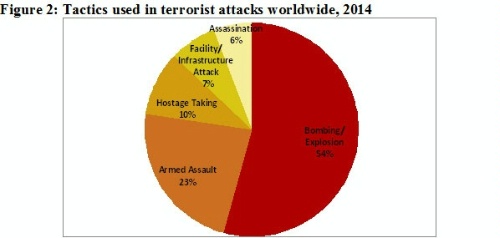
This essay focuses on radical Islamic terrorism, from its roots in the Shia rebellion that led to the Iranian Revolution to the modern day terrorist group Daesh/ISIL/ISIS/IS. It discusses how 9-11 introduced many Westerners to the idea of radical Islamic terrorism and the self-proclaimed holy warriors who carry out these acts as a form of jihad. In order to help explain modern terrorism, the paper discusses the roots of the Sunni/Shia split and the lingering impact that split has on the modern geopolitical environment. The foundation of modern terrorist groups that can be traced to the radicalization of Sunni students is traced through Al Qaeda and back to the Taliban.
For people in the United States, radical Islamic terrorism became a real threat on 9-11, when terrorists from a group known as Al-Qaeda used box knives to take over airplanes and then used those airplanes as missiles to destroy the World Trade Center in New York City, and to target the Pentagon in Washington, DC. A fourth plane was intended to be an additional weapon, but passengers on the plane thwarted them. The day remains the largest terrorist attack on American soil and ushered in the second Iraq war and an era of abrogated civil rights under the umbrella of The Patriot Act, a government attempt to heighten monitoring of potential terrorists and prevent another 9-11 style attack (United States Department of Justice, 2016). It also brought attention to a new type of threat; jihad, as these terrorists styled themselves as holy warriors.
While members of Al Qaeda and subsequent terrorist groups have called themselves mujahideen, jihadists, and jihadi and have proclaimed that their actions are taken in the name of Islam, it is important to understand that their take on the concept of jihad is a radicalized version of the religion that differs, significantly, from what the average Muslim believes. For the average Muslim, Jihad is not a violent concept and does not incorporate terrorism, and the Koran specifically prohibits almost all calls for violent Jihad. In addition, Islam is an Abrahamic religion like Christianity and Judaism, and the Koran requires Muslims to respect Christians and Jews. Radicalized Muslims, like radicalized members of other faiths, reject those concepts and use twist Islam to support their violence against others. However, the root cause is not simply religion; religion is a tool manipulated by the leaders to get vulnerable recruits to join their cause. Factors such as poverty, class differences, warfare, and even social anti-Muslim attitudes are used as recruiting tools alongside religion.
Furthermore, it is important to realize that Islam has been marked by an internal division since the 632 AD death of the prophet Muhammad. Sunni and Shia Muslims are divided over who is the appropriate successor to the prophet Muhammad. While many in the Western world view all Muslims as the same, this division marks significant doctrinal differences and is the source of many territorial disputes (Humphreys, 2015). In a nutshell, the Shia believed that only descendants of Muhammad were eligible to lead Muslims, advocating for a type of monarchy in religious succession. In contrast, the Sunni believed that the worthiest people should be eligible for leadership, regardless of lineage. The Iranian Revolution, which was led by Shia and marked the foundation of the terrorist organization Hezbollah, caused many people to think of Shias as the more radicalized of the two groups, which was a viewpoint advocated by primarily Sunni Saudi Arabia and many of its political backers, including the United States. However, the Sunni version of Islam was equally subject to radicalization; the Taliban, which began as a group of mujahideen fighting against the Soviet occupation of Afghanistan, was a Sunni group, and its radicalized ideology formed the foundation for Al Qaeda.
Terrorism is the use of violence and intimidation to further political aims, and it can be accomplished by an individual or an organization. What the United States government found in the wake of 9-11 was that it is extremely difficult to fight a terrorist organization such as Al-Qaeda. While the organization had a well-recognized leader, Osama Bin Laden, it did not function in a top-down manner, but instead employed terrorist cells, small groups of independently operating terrorists who do not share leadership and do not overlap, which makes it far more difficult for law enforcement to target a terrorist organization. This effective use of terrorist cells was globally devastating, “al-Qaeda was linked—whether directly or indirectly—to more attacks in the six years following September 11 than it had been in the six years prior, including attacks in Jordan, Kenya, Saudi Arabia, Indonesia, Turkey, the United Kingdom, Israel, Algeria, and elsewhere” (Encyclopaedia Britannica, 2016). Meanwhile, the organization was extremely effective at using social media and the Internet as both a recruiting device and a means of spreading terror. The U.S. found its leader, Osama Bin Laden, and executed him in May of 2011, and, although Al-Qaeda remains an active terrorist organization, it has largely been supplanted by other organizations.

While Al Qaeda was once the most-feared radical Islamic terrorist organization in the world, currently, the most-feared group of terrorists is a radical Sunni group that is referred to by one of many names: Isis, Isil, IS, and Daesh. The names all refer to “the jihadist group which controls large swathes of territory in Syria and Iraq” (Irshaid, 2015). The conflict over the name, which has gained significant attention in the United States, is really a semantic one. Historically, there was an Islamic State at the time of Muhammad’s death, and the terrorists attempt to use that and related monikers to legitimize their operation. These names include Islamic State (IS), Islamic State in Iraq and Syria (ISIS), and Islamic State in Iraq and the Levant (ISIL) and the confusion over the names can be traced to translation difficulties between Arabic and English. However, the group is generally referred to as ISIL in international contexts, which is what the Obama Administration has continued to do, while many Americans refer to them as ISIS. The term Daesh, which is simply the English acronym of the group’s Arabic name and as no stand-alone meaning, is gaining in popularity, because it does not lend the same legitimacy to the group as IS or any of its derivatives.
Regardless of what one calls the group, ISIL is having a tremendous impact on worldwide politics, because ISIL invasions of previously peaceful Muslim countries are driving a world-wide refugee crises and altering the balance of power in the Middle East. The geo-political implications of a Sunni group controlling parts of Syria and Iraq, while an equally militant Shia group largely controls Iran are alarming and fighting between radicalized Muslims and non-radicalized citizens could have very alarming consequences and has made much of the Western world very aware of concerns about nuclear weapons in Muslim-controlled countries like Pakistan and Iran. It has also helped drive xenophobia in many nations, because they fear that Muslim immigrants will bring radical Islam to their countries. This fear is reasonable, but greatly overstated; the refugees are fleeing the radical Islamists, but it is still possible for a terrorist to pretend to be a refugee in order to enter a target country. More chilling is the idea that a refugee may flee the terrorists only to face tremendous religious discrimination and economic oppression, making him or her more vulnerable to terrorist recruitment propaganda.
Encyclopedia Britannica. (2016, October 14). Al-Qaeda. Retrieved October 19, 2016 from the Encyclopaedia Britannica website: https://www.britannica.com/topic/al-Qaeda
Humphreys, A. (2015, November 18). The Sunni-Shia split at the heart of regional conflict in the Middle East explained. Retrieved October 19, 2016 from National Post website: http://news.nationalpost.com/news/world/the-sunni-shia-split-at-the-heart-of-regional-conflict-in-the-middle-east-explained
Irshaid, F. (2015, December 2). Isis, Isil, IS, or Daesh? One group, many names. Retrieved October 19, 2016 from BBC website: http://www.bbc.com/news/world-middle-east-27994277
United States Department of Justice. (2016). Highlights of the USA Patriot Act. Retrieved October 19, 2016 from Department of Justice website: https://www.justice.gov/archive/ll/highlights.htm
Top Image Rights: Taken Oct 30, 2011 Siwc Flickr Creative Commons CC by 2.0
